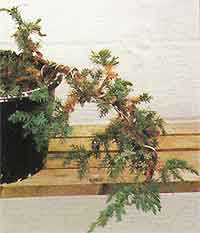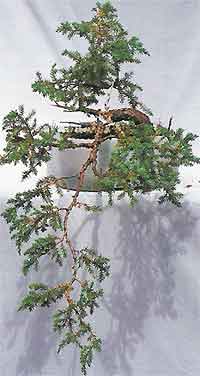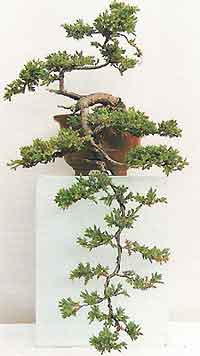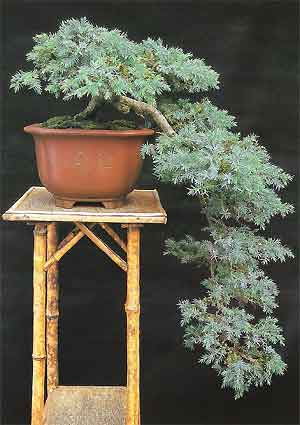Bonsai Trees
Case Histories
Juniper - (juniperus squamata 'blue carpet')
Juniper Bonsai Style: Cascade

This is one of the first trees that I ever began to train as a bonsai and I find it satisfying that after many years it has become a very natural looking cascade style bonsai.
The juniper started life as a small cutting which I had successfully rooted. After letting it grow for only a year, and this being in my early bonsai years when I was inexperienced, I was keen to wire it in a shape of some kind, but had no clear style in mind. The result was a small and twisted, informal upright tree.

However, the next day I decided that the juniper would be better suited growing in a cascade manner and so the trunk was bent downwards and initial training commenced. This was an improvement and I was pleased with my decision.
One year later and I had lost interest in this tree, having so many other potential bonsai trees which seemed more important. I decided that the juniper belonged in the garden and so it was planted in a corner of my rockery.
Juniper Bonsai History: Training

Four years later I was more experienced in growing and styling bonsai and my interest in larger trees was developing. By now the juniper had made so much growth that there was a danger of it taking over the rockery completely. The branches had extended and the foliage was lush.
On studying the tree closely I realised that perhaps there really was potential in this tree after all and one day in the spring I decided to dig it up. I was amazed at how thick the trunk had become, with a most attractive downwards curve. The tree was now very large indeed, compared to most of the trees in my bonsai collection at that time. It was potted into a shallow plastic container, pruned heavily so that there would be less foliage for the roots to support and some of the branches were wired into shape.
In the spring I planted the juniper into a cascade style bonsai pot that I had recently purchased for it. I pruned and wired the foliage masses, expecting it to grow well that season, but it didn't. In fact it hardly grew at all and looked rather unhealthy.

I was puzzled as to why this should be the case. The following year it was not repotted and it perked up slightly, but did not respond well to feeding, generally looking rather sorry for itself. I moved it to different positions in the garden, full sun, partial shade, full shade, but something was definitely wrong with the tree.
Its growth was poor and I began to realise that it must be a root problem. That spring I thoroughly examined the roots and found at the centre of the root ball a large amount of heavy clay soil from the garden. The roots had been really struggling in this unsuitable soil and I removed as much of it as I could, replacing it with a very open and gritty mix. Several weeks later the tree began to respond. I was pleased to see it budding well and it has grown strongly ever since.
 This is one of the first trees that I ever began to train as a bonsai and I find it satisfying that after many years it has become a very natural looking cascade style bonsai.
This is one of the first trees that I ever began to train as a bonsai and I find it satisfying that after many years it has become a very natural looking cascade style bonsai. However, the next day I decided that the juniper would be better suited growing in a cascade manner and so the trunk was bent downwards and initial training commenced. This was an improvement and I was pleased with my decision.
However, the next day I decided that the juniper would be better suited growing in a cascade manner and so the trunk was bent downwards and initial training commenced. This was an improvement and I was pleased with my decision. Four years later I was more experienced in growing and styling bonsai and my interest in larger trees was developing. By now the juniper had made so much growth that there was a danger of it taking over the rockery completely. The branches had extended and the foliage was lush.
Four years later I was more experienced in growing and styling bonsai and my interest in larger trees was developing. By now the juniper had made so much growth that there was a danger of it taking over the rockery completely. The branches had extended and the foliage was lush. I was puzzled as to why this should be the case. The following year it was not repotted and it perked up slightly, but did not respond well to feeding, generally looking rather sorry for itself. I moved it to different positions in the garden, full sun, partial shade, full shade, but something was definitely wrong with the tree.
I was puzzled as to why this should be the case. The following year it was not repotted and it perked up slightly, but did not respond well to feeding, generally looking rather sorry for itself. I moved it to different positions in the garden, full sun, partial shade, full shade, but something was definitely wrong with the tree.